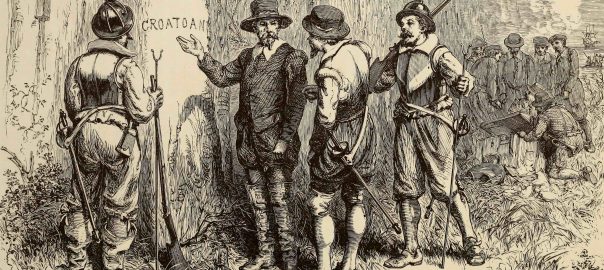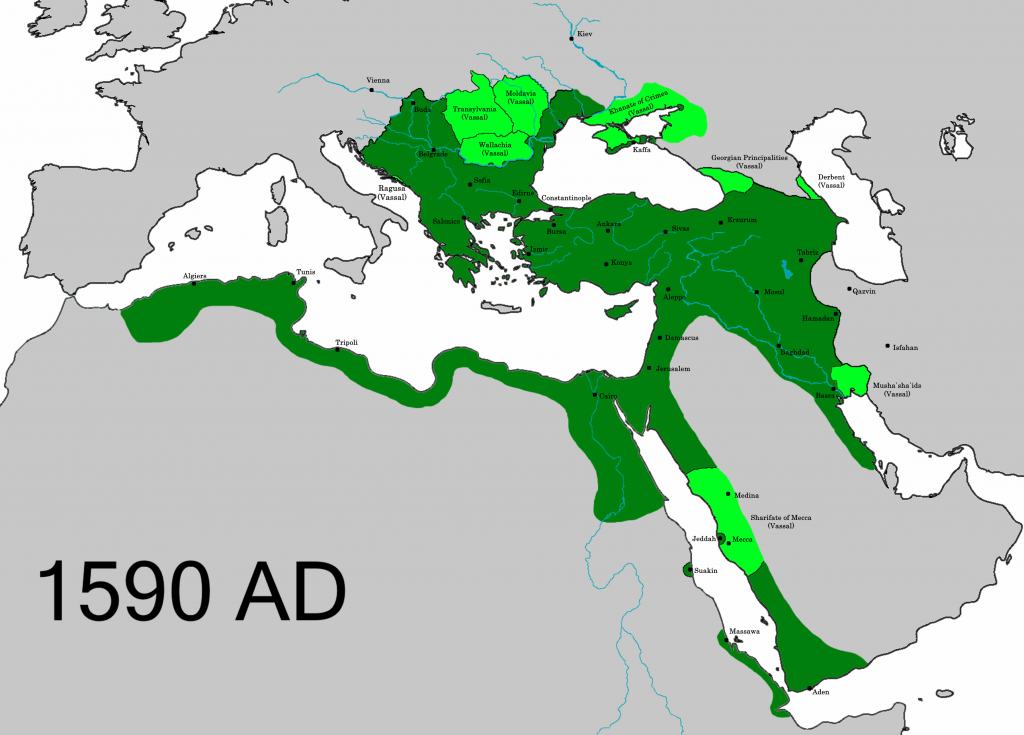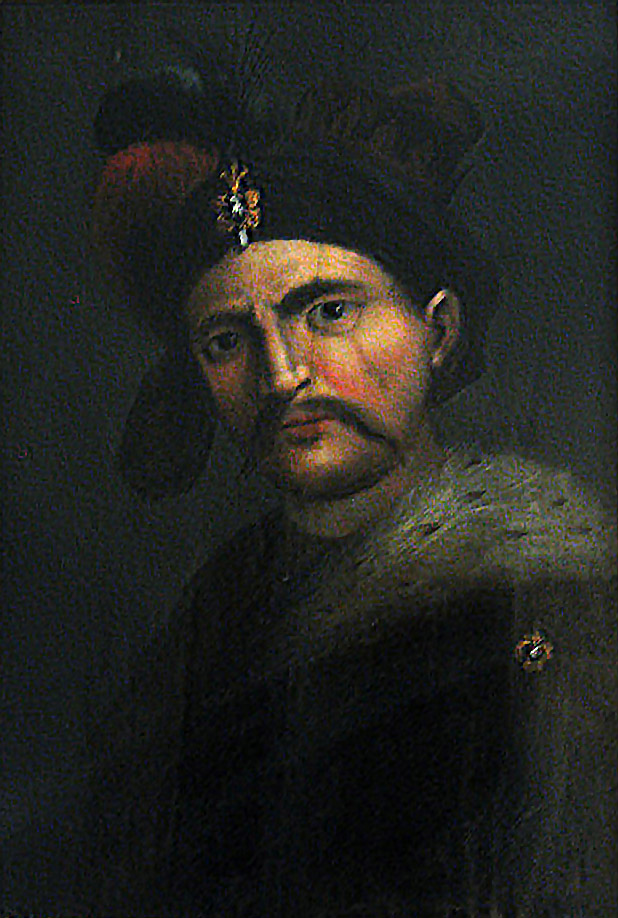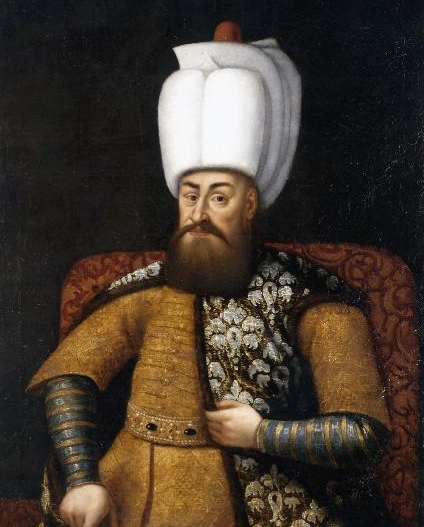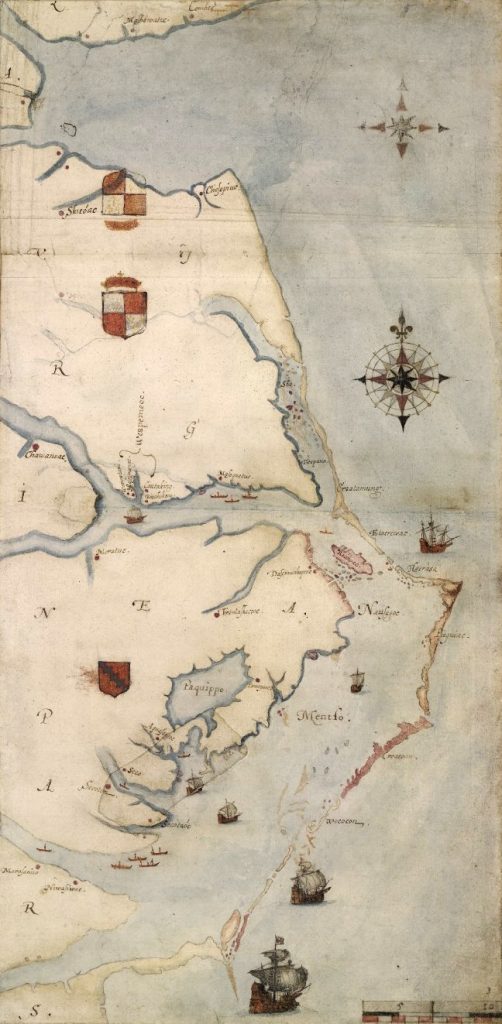We’ll start with the peace treaty concluded in 1590 between the Ottomans and Safavids, look at England’s still-sputtering attempts to establish colonies in North America, then look at a couple of ways in which the pursuit of empire placed costs on the citizens of societies pursuing empire (though still, of course, far far smaller than the costs imposed on all members of the societies that were colonized/imperialized.)
Ottomans and Safavids make peace
The Treaty of Constantinople of March 1590 ended the Ottoman-Safavid War that had been fought since 1578. The war had started when the Ottomans, under Murad III, invaded Safavid possessions in Georgia, during a period when they (rightly) perceived the Safavids to be weak and poorly ruled– that was at the time when Muhammad Khodabanda had just started his ill-fated reign in Qazvin.
In 1587, as we know, M. Khodabanda was succeeded by his son Abbas, who turned out to be a smart and wily ruler.
English-WP tells us:
The kingdom Abbas inherited was in a desperate state. The Ottomans had seized vast territories in the west and the north-west (including the major city of Tabriz) and the Uzbeks had overrun half of Khorasan in the north-east. Iran itself was riven by fighting between the various factions of the Qizilbash, who had mocked royal authority by killing the queen in 1579 and the grand vizier Mirza Salman Jabiri in 1583.
First, Abbas settled his score with his mother’s killers, executing three of the ringleaders of the plot and exiling four others. His next task was to free himself from the power of [Qizilbash leader] Murshid Qoli Khan… Meanwhile, the Uzbeks continued their conquest of Khorasan. When Abbas heard they were besieging his old friend Ali Qoli Khan Shamlu in Herat, he pleaded with Murshid to take action. Fearing a rival, Murshid did nothing until the news came that Herat had fallen and the Uzbeks had slaughtered the entire population. Only then did he set out on campaign to Khorasan. But Abbas planned to avenge the death of Ali Qoli Khan, and he arranged for four Qizilbash leaders to kill Murshid after a banquet on 23 July 1589. With Murshid gone, Abbas could now rule Iran in his own right.
Abbas decided he must re-establish order within Iran before he took on the foreign invaders. To this end he made a humiliating peace treaty – known as the Treaty of Istanbul – with the Ottomans in 1590, ceding to them the provinces of Azerbaijan, Karabagh, Ganja, Dagestan, and Qarajadagh, as well as parts of Georgia, Luristan and Kurdistan. This demeaning treaty even ceded the previous capital of Tabriz to the Ottomans.
However, concluding this humiliating treaty probably turned out to be a wise move. Throughout the 1590s, Abbas would focus on consolidating his empire, including by radically reducing the power of the Qizilbash chieftains. In 1598, he was ready to take on the Uzbeks with his reorganized army, and regained considerable land from them. And starting in 1603 he took on the Ottomans, regaining all the lands he had ceded at the Treaty of Constantinople and the years of war that had preceded it.
An Anglo-Ottoman footnote
I’ve been reading a few papers (via Academia.edu) on outreach the English court and English merchant companies had conducted with the Ottomans in the latter third of the 16th century. Including this one by Gabor Agoston, this one by Steven Roy, and this one by Christine Woodhead. (Sadly, membership is required for access there.)
The basis of the Anglo-Ottoman relationship in those years was, not surprisingly, their shared hatred/fear of Spain.
Agoston and Roy go into quite some detail on how important English exports of war-related materials were to the Ottomans– especially tin for making the brass alloys needed for sturdy cannons.
Ágoston wrote (p.184):
In May 1580, the Sultan issued a charter of privileges granted to the English merchants which formed the basis of Anglo-Ottoman trade relations for many centuries, and was almost the same as that given to the French traders in 1569. Anglo-Ottoman trade relations were strengthened by the work of the first English diplomatic mission, led by Harborne between 1583-1588, and by the English consulates founded in Egypt, Syria, Algeria, Chios and in Patras.
During the Ottoman-Safavid war of 1578-1590 English ships sailed into the port of Constantinople several times, carrying tin, metal, guns and textile fabrics. On March 29, 1585, Giovanni Francesco Morosini, the Venetian ambassador in Constantinople, informed the Republic of an English ship which “arrived with a cargo of cloth, tin and other goods”. He also reported that the Ottomans were pleased with the cargo as they had hardly any cloth in the city. A year later, on March 17, 1586, Lorenzo Bernardo, the Venetian ambassador in Constantinople, sent a report to the Doge and to the Senate, in which he informed them of an English ship which had entered port a few days earlier and unloaded tin and cloth. In all probability, the ship did not have any intention of hiding its cargo as “she made a great noise with her gun. In a few days she sold off her cargo and sailed away in ballast”.
Whitehead’s short paper glosses her research in the UK’s (privatized!) “State Papers Online” collection. It contains some interesting nuggets. E.g., this:
The English traveller Fynes Moryson recorded that when the Ottoman Sultan Murad III (1574–95) was shown the location of England on a map he peered at it in astonishment and wondered aloud why the King of Spain did not take a spade, dig it up and throw it into the sea. The Sultan then reflected on the great influence and achievements of the Queen of England from such a small base. With one exception, this anecdote acknowledges all the principal elements of Anglo-Ottoman relations during the reign of Elizabeth I: anti-Spanish and anti-Catholic diplomacy, maritime concerns, communication difficulties due to distance, and the fact that the English sovereign was a woman. The exception, which underlay all other elements, was commerce.
She notes this:
Commercial activity… provided both the original pretext and the continuing framework for early English relations with the Muslim world. It enabled spices, silks, carpets, currants and other luxury items to be brought directly and more cheaply to England, without passing through entrepots such as Venice or Antwerp. However, the political aspect was always prominent, and controversial from the start. This was due partly to the fact that the Turkey/Levant Company’s commercial representative in Constantinople was also expected to serve as the Queen’s ambassador, with all the disputes over finance, status and responsibilities which this entailed.
And finally, this:
The principal items in the State Papers Foreign for Turkey and the Barbary Coast in the later years of the reign of Elizabeth I provide an invaluable insight into the difficulties of establishing new diplomatic relations, in particular the practical aspects of long-distance communication and the implications these had for the ambassador’s actions in Constantinople…. Letters were often sent in several copies by different courier routes. Those via Poland or Venice were the most usual, though in neither direction was the post reliable and communications could often take around four months one way. In January 1584 [Amb.] Harborne was dismayed to discover that his first 11 letters as ambassador had been intercepted, probably by the Venetians, and had never arrived in London. In November 1592 [Amb.] Barton received eight London letters in one batch, the earliest dated 6 May. Correspondence by sea might have been quicker, but ran the risk of capture by Spanish ships near Gibraltar.
England loses a colony
Walter Raleigh, one of Elizabeth’s favorite maritime adventurers, had sent someone to found the first English colony in the area of today’s USA back in 1585. That colony was called Roanoke, though it was in the area of the Outer Banks of today’s North Carolina. That tiny colony foundered and collapsed.
In 1587, Raleigh sent a guy called John White to lead an expedition to establish the Cittie of Raleigh in the Chesapeake Bay– based on the idea that this body of water pretty certainly connected with the long-sought “Northwest Passage” to the East Indies. White would the “Governor” of the new colony, with 12 assistants:
Approximately 115 people agreed to join the colony, including White’s pregnant daughter Eleanor and her husband Ananias Dare. The colonists were largely middle-class Londoners, perhaps seeking to become landed gentry. Manteo and Towaye [two native Americans], who had left the Lane colony with Drake’s fleet [that is, been kidnapped from their homes by Drake], were also brought along. This time, the party included women and children, but no organised military force.
Though they were en route for the Chesapeake, White’s little fleet stopped in North Carolina to see what had happened to “Roanoke”, and while they were there White’s pilot insisted that the whole band of colonists should remain in that vicinity. Also, White’s grand-daughter was born in the infant colony– and was baptized “Virginia”. But the colonists faced tough times (lack of food, hostility from indigenes…) White decided to return to England, intending to bring more supplies back to “his” colony the following year. His daughter and her family were among those left in the colony.
But guess what. The Spanish Armada intervened. In 1588, White could get hold of only two small boats in England with which to take supplies back to Roanoke, but they fell prey to French “pirates”. He wasn’t able to get back to Roanoke again until 1590, when he did so by hitchhiking with an English privateering expedition. Most of the privateers’ group would spend the summer in the Caribbean, raiding Spanish boats there, but White got to take two ships, Hopewell and Moonlight, on up to “Roanoke” and nearby “Croatan Island” in N. Carolina.
White and the others made landfall in Roanoke on August 18 (his granddaughter’s third birthday). English-WP tells us that they,
found fresh tracks in the sand, but were not contacted by anyone. They also discovered the letters “CRO” carved into a tree. Upon reaching the site of the colony, White noted the area had been fortified with a palisade. Near the entrance of the fencing, the word “CROATOAN” was carved in one of the posts. White was certain these two inscriptions meant that the colonists had peacefully relocated to Croatoan Island, since they had agreed in 1587 that the colonists would leave a “secret token” indicating their destination, or a cross pattée as a duress code.
Within the palisade, the search party found that houses had been dismantled, and anything that could be carried had been removed. Several large trunks (including three belonging to White, containing the belongings he left behind in 1587) had been dug up and looted. None of the colony’s boats could be found along the shore.
(The banner image above is a depiction of those events.)
After several more adventures with bad weather, etc., the two ships arrived back in England in October. Walter Raleigh made a few desultory attempts to find out what had happened to the “Lost Colony” of Roanoke, but his main concern was not to lose his “permit” from Elizabeth to own and to colonize all of “Virginia”.
As for John White, he was notable among the early English colonizers of the Americas for his strong interest in painting– not just the kinds of maps the colonists needed, but also depictions of the peoples and natural history of the areas he visited. WP:
During White’s time at Roanoke Island, he completed numerous watercolor drawings of the surrounding landscape and native peoples. These works are significant as they are the most informative illustrations of a Native American society of the Eastern seaboard, and predate the first body of “discovery voyage art” created in the late 18th century by the artists who sailed with Captain James Cook. They represent the sole-surviving visual record of the native inhabitants of America encountered by England’s first settlers.
White’s enthusiasm for watercolor was unusual – most contemporary painters preferred to use oil-based paints. White’s watercolors would soon become a sensation in Europe; it was not long before the watercolors were engraved by the Flemish master engraver Theodore de Bry. Through the medium of print, the illustrations became widely known and distributed; they were published in 1590 under the title America.
And this: “The loss of the colony was a personal tragedy for White, from which he never fully recovered.”
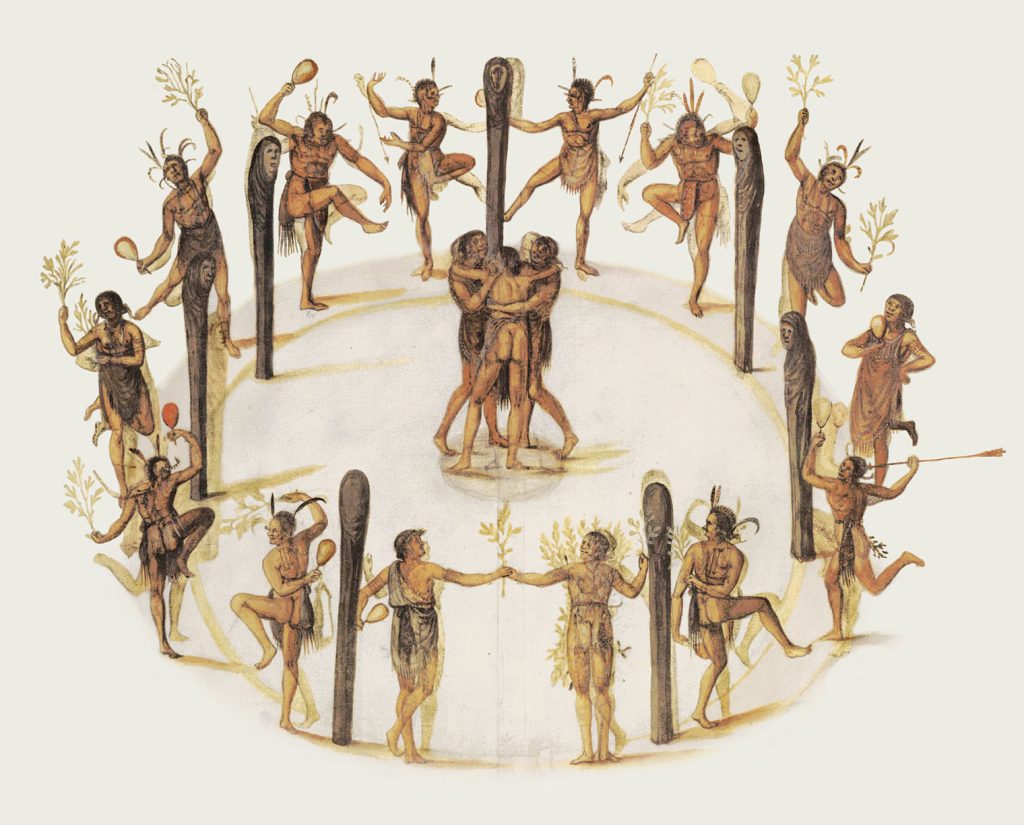
White painting of an Algonquian ritual 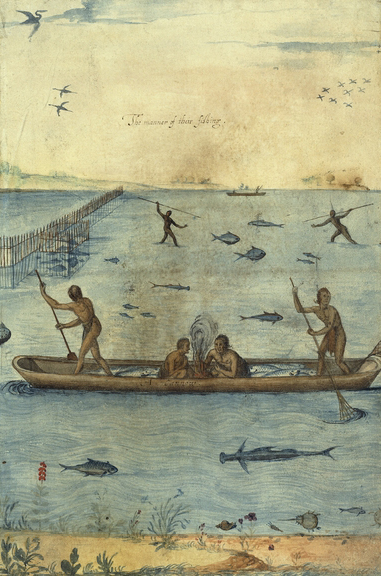
White painting of Algonquian fishers 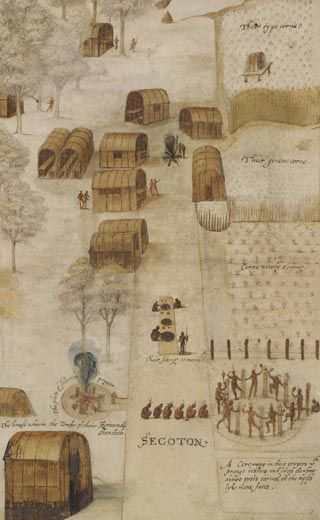
White painting of Secoton village 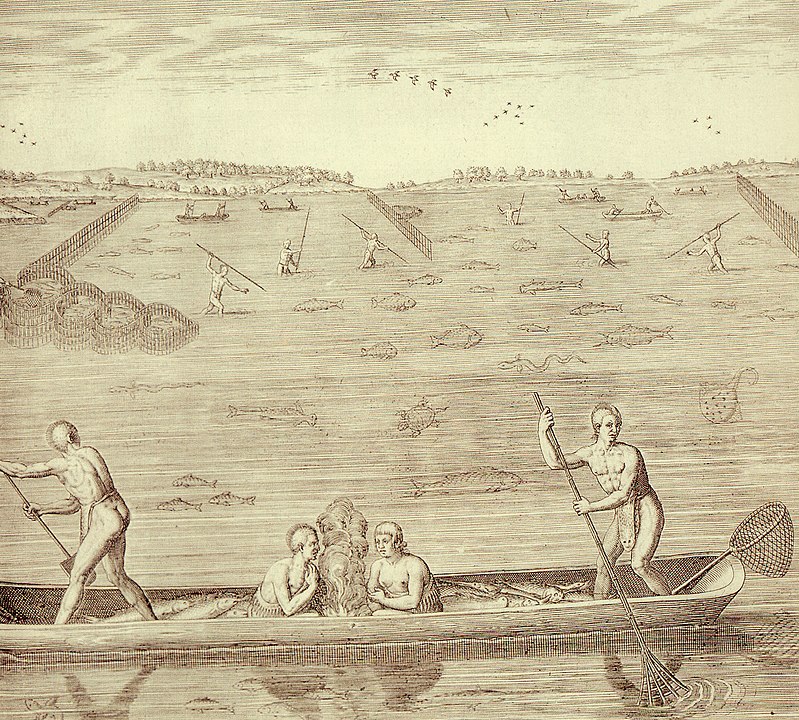
Engraving made of White’s painting of fishers
Spanish King forced to inaugurate a sales tax
So much for the costs of maintaining imperial swagger!
In April 1590, Spain’s parliament the Cortes de Castilla imposed a new, indirect sales tax on four vital foodstuffs: wine, meat, olive oil and vinegar. This tax, called the millones “was initially intended in 1590 as a temporary measure to replace the Spanish Armada, which had been lost in attacking England.” It was a 6-year grant for 8 million ducats.
English-WP reminds us (as should have been evident, anyway), that: “The tax burden was a factor in the impoverishment of the Castilian populace in the 17th century because it increased the prices of the most basic goods… “
